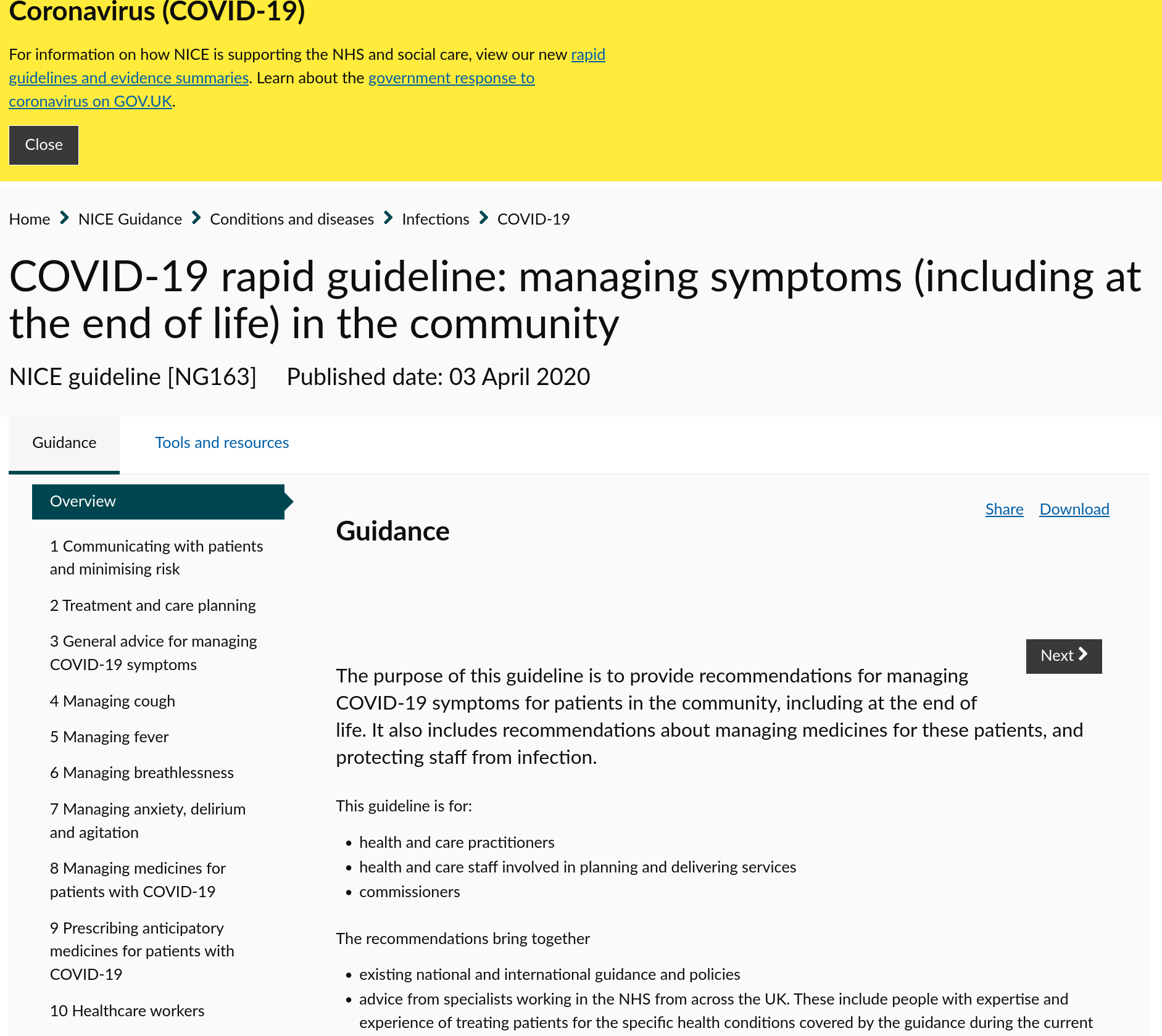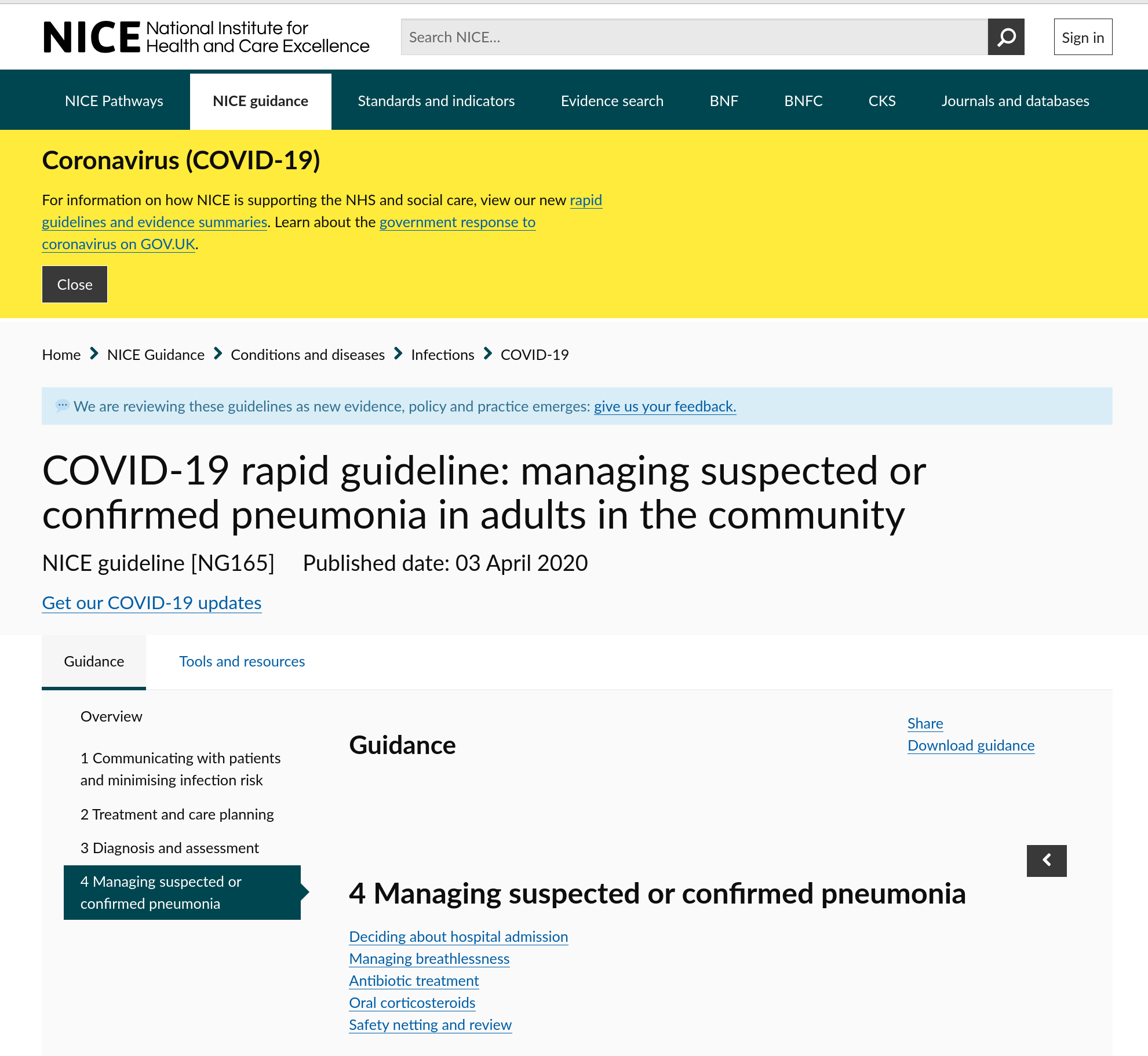The NICE Guideline of Ng163 was recommended in April 2020. If you search for this guideline today you’ll be greeted with the following url telling you this guideline has been superceded. If you use the archive.org wayback machine (which archives web pages) you can get the full protocol that enabled murder on a wide scale in Britain.
Ng163 was used to kill off a significant amount of elderly people in Britain under the cover of Covid 19.
Managing Breathlessness
In the wayback machine on Ng163 we find the following table. I also managed to obtain a pdf of the guide lines here. You might be stunned to read about “End-of-life treatments”. Why was the government deciding on when people would be “end-of-life”?
Table 4 End-of-life treatments for managing breathlessness for patients aged 18 years and over
| Clinical scenario | Treatment |
| Opioid naive (not currently taking opioids) and able to swallow | Oral treatment Morphine sulfate immediate-release 2.5 mg to 5 mg every 2 to 4 hours as required or morphine sulfate modified-release 5 mg twice a day, increased as necessary (maximum 30 mg daily) |
| Already taking regular opioids for other reasons (for example, pain relief) | Oral treatment Morphine sulfate immediate-release 5 mg to 10 mg every 2 to 4 hours as required or one twelfth of the 24-hour dose for pain, whichever is greater |
| Unable to swallow | Parenteral treatment Morphine sulfate 1 mg to 2 mg subcutaneously every 2 to 4 hours as required, increasing the dose as necessary If needed frequently (more than twice daily), a subcutaneous infusion via a syringe driver may be considered (if available), starting with morphine sulfate 10 mg over 24 hours |
| Special considerations See BNF for more details on formulations and dosages of morphine sulfate. If breathlessness is not continuous, intermittent opioid dosing may be appropriate If estimated glomerular filtration rate (eGFR) is less than 30 ml per minute, use equivalent doses of oxycodone instead of morphine sulfate (see Prescribing in palliative care in the BNF for more details) Consider concomitant use of an antiemetic (such as haloperidol) and a regular stimulant laxative (such as senna) Continue with non-pharmacological strategies for managing breathlessness when starting an opioid Opioid patches should not routinely be used in patients who are opioid naive because of the time it takes for the medicine to get to steady state for clinical effect and the high morphine equivalence (see Prescribing in palliative care in the BNF for more details) Add a benzodiazepine if required For breathlessness and anxiety: lorazepam 0.5 mg sublingually when required (maximum 4 mg daily) Reduce the dose to 0.25 mg to 0.5 mg in elderly or debilitated patients (maximum 2 mg in 24 hours) For associated agitation or distress: midazolam 2.5 mg to 5 mg subcutaneously when required (see BNF for more details on dosages) Sedation and opioid use should not be withheld because of a fear of causing respiratory depression |
You will be quite stunned to read at the bottom
Sedation and opioid use should not be withheld because of a fear of causing respiratory depression
A doctor or nurse might be forgiven for not wanting to give a breathless patient midazalom because the US National Library of Medicine has this important warning on their website.
Midazolam injection may cause serious or life-threatening breathing problems such as shallow, slowed, or temporarily stopped breathing that may lead to permanent brain injury or death. You should only receive this medication in a hospital or doctor’s office that has the equipment that is needed to monitor your heart and lungs and to provide life-saving medical treatment quickly if your breathing slows or stops. Your doctor or nurse will watch you closely after you receive this medication to make sure that you are breathing properly. Tell your doctor if you have a severe infection or if you have or have ever had any lung, airway, or breathing problems or heart disease. Tell your doctor and pharmacist if you are taking any of the following medications: antidepressants; barbiturates such as secobarbital (Seconal); droperidol (Inapsine); medications for anxiety, mental illness, or seizures; opiate medications for cough such as codeine (in Triacin-C, in Tuzistra XR) or hydrocodone (in Anexsia, in Norco, in Zyfrel) or for pain such as codeine, fentanyl (Actiq, Duragesic, Subsys, others), hydromorphone (Dilaudid, Exalgo), meperidine (Demerol), methadone (Dolophine, Methadose), morphine (Astramorph, Duramorph PF, Kadian), oxycodone (in Oxycet, in Percocet, in Roxicet, others), and tramadol (Conzip, Ultram, in Ultracet); sedatives; sleeping pills; or tranquilizers. (Mediline.gov, Midazolam Injection, 04/15/2017)
The aim was to kill as many old people as possible however. The bodies from the pandemic came from these protocols to lock down society, strip civil liberties and see how many people they could get away with murdering.



